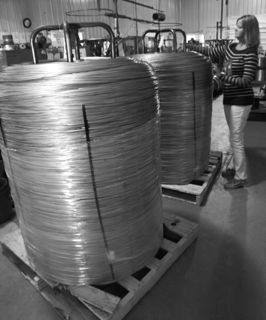East Coast Lightning Equipment
East Coast Lightning Equipment owner Jennifer Morgan at her lightning rod factory in Winsted. Photographs by Bruce Frisch.
Business Up By 30 Percent
By Bob Bumcrot
Lightning cannot be avoided; it needs to be controlled. A typical strike, coming in at 90,000 miles per second, carries around 30 million volts of electricity. It must be acquired at many points along the roof line and conducted to the ground. Thus the lightning rod
Modern houses, with more metal than in earlier times as well as costly electronic equipment inside, are in more need of lightning protection than ever. A number of Norfolk houses, including Kate and Martin Johnson’s “green” home and Rosanna Trestman’s Riggs Hill Farm, have systems that use ECLE components.
Eight years ago this newspaper profiled Norfolk’s Jennifer and Mark Morgan of East
Coast Lightning Equipment (ECLE), the Winsted-based company that they had recently
purchased from Jen’s parents. Since then the company has continued to grow and
prosper thanks to their energetic leadership, the adoption of the “lean manufacturing”
approach invented by the Japanese car maker, Toyota, and a watchful eye to the
future.
ECLE’s reputation reaches far beyond Winsted. They do not install lightning protection
systems, rather they manufacture and distribute over 1000 components to at least
70 lightning protection specialists throughout the country for both commercial and
residential buildings.
“I’m the third generation to be involved in lightning protection,” said Jen Morgan. Her
parents, Chuck and Judy Ackerman, opened the Ackerman Lightning Protection Co. in
1967. It became ECLE in 1984 and remains in the present location.
Under the Morgan’s stewardship, the family business has grown and modernized.
Since 2004, Jen has doubled ECLE’s brand recognition through seminars, trade shows,
and newsletters aimed at architectural and engineering firms. Each day she devotes
time to marketing and promotion, as well.
Mark Morgan is the company president and is an integral part of the daily operations on
the factory floor. He is also in charge of quality control and product compliance. On the
national front, he is on the technical committees of Underwriters Lab and the National
Fire Protection Association where the actual lightning protection regulations are written.
Additionally, he serves on the board of three professional associations in the field.
Business is up by at least thirty percent. Mark attributes some of the company’s
success to the adoption of the Toyota Production System (TPS). They first learned of
the system through seminars and went on to visit the Toyota factory in Georgetown,
Kentucky to watch it in action. The main objectives of the TPS are to structure company
methods and processes so as to eliminate “muri, mura, and muda'” Japanese for
overburden, inconsistency and waste, through a process of continuous improvement
and respect for people. Impressed, the Morgans brought the system back to their
Winsted operations, which turned out to be a success story. “Once the self-sustaining
system was in place, we didn’t need outside monitoring,” said Mark.
Jen explains on how the TPS (also commonly referred to as “lean manufacturing) has benefitted their own factory. “In the ECLE operations, the workers move from machine to machine during the day based on what products the customers order. It’s not unusual for a worker to make 15 different types of products in a day.” This cross
training makes for a more versatile workforce and greatly reduces repetition motion injuries that are common in traditional factory settings.
Clearly, the Morgans have mastered this system of marrying the product to production, setting them apart from the competition. “We are so efficient with our processes,” Jen boasts, “that many items that leave the factory in the afternoon were still raw ingot in the morning.”

